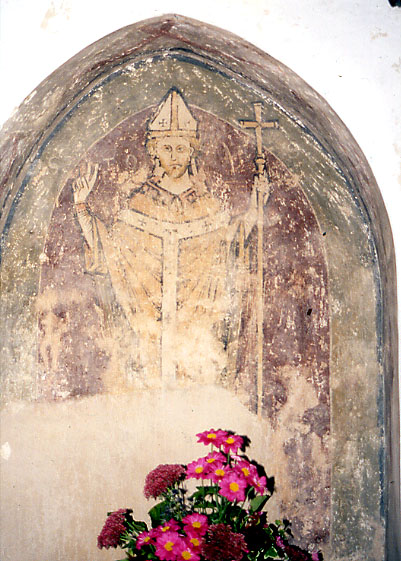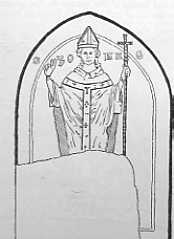Hauxton, Cambridgeshire (†Ely) C.13
St Thomas Becket
“March 13 1643. [At Hauxton] We destroyed a crucifix, three popish pictures,
an inscription on brass, and ordered the steps to be levelled…”.
(The Journal of William Dowsing)¹

By the time the Suffolk iconoclast and Parliamentary Visitor Dowsing arrived, the niche on the south side of the chancel arch in which this image is painted had been walled up, hence its survival. It was uncovered in 1860, in remarkably good condition apart from the damage to the lower part where a ‘squint’ to enable people in the nave to see the high altar had been cut through the wall sometime in the intervening years. Such few paintings of Becket as remain usually show his martyrdom, and this is a very rare example of the saint as a standing, archiepiscopal figure. It is also one of the earliest paintings of him in existence – an altar, built in 1229, little more than 50 years after Becket’s canonization, was originally here and presumably it was dedicated to him.

Identification of the painting is certain because of its inscription, still visible. This, painted in Lombardic capitals, begins at the left on the green-painted soffit of the arch, at the level of Becket’s right hand. It reads: ‘St TO’ (on the red background, beside the saint’s fingers) ‘MA’ (on the red background at the right of his head [obscured]) and finally ‘S’ (on the green soffit at the right). Sometime before 1925, JC Wall drew the painting, and his drawing² (left) shows the inscription when it was less faded and obscure.
I suspect that there may once have been more to this inscription. Some small, white cursive shapes are faintly detectable on the red background to the right of Becket’s crozier, on the level of his right elbow. There is something like a faint ‘O’ and below that perhaps a ‘P’. If so, the inscription might originally have continued…‘ORA (TE) PRO NOBIS’. Quite possible, especially if this is in effect an altarpiece, and an indication of the enormously high regard in which Becket and his intercessory powers were held.
¹ Quoted here from the leaflet in the church. Dowsing’s Journal is now online, and his activities in Suffolk and Cambridgeshire are documented at Digiatlas: The Journal of William Dowsing. NB. This is an amended link to a new location.
² JC Wall, Medieval Wall Paintings, (nd, before 1925), Talbot & Co., London, Fig. 76, p.181. It is possible that a relative of JC Wall, or a representative of the interests of Talbot & Co. still holds copyright in this drawing, if so, I hope that they will contact me. But I reproduce the drawing in the certainty that Wall himself would have been delighted to see it here.